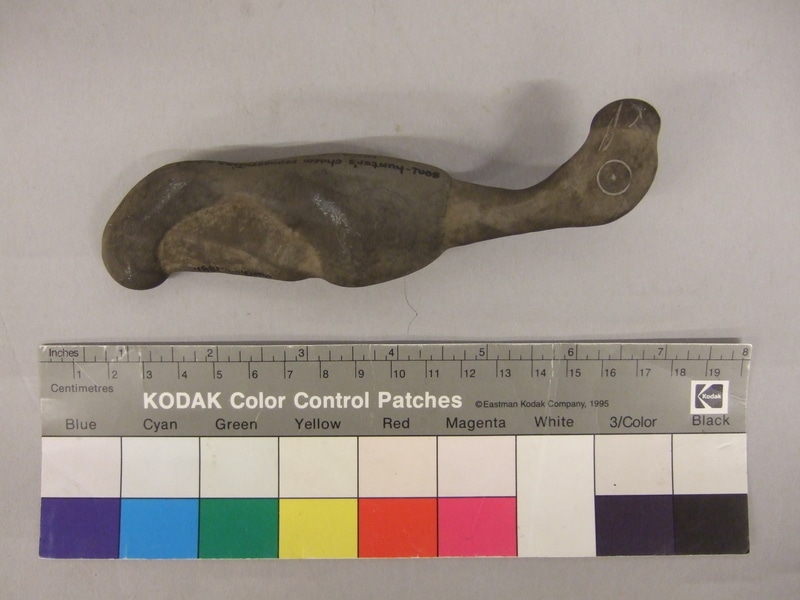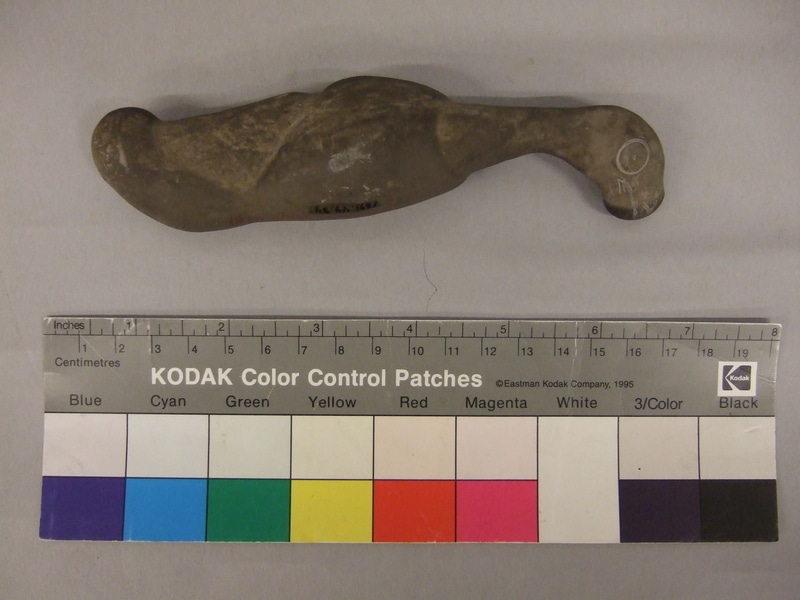Amulet Item Number: 1891.49.34 from the Pitt Rivers Museum


Description
Natural stone bearing some resemblance to a bird or animal. [DCF Court Team 13/11/2002]
Longer Description
Natural stone bearing some resemblance to a bird or animal. Greyish coloured stone, worn smooth by natural processes and likely also human processes. At one end, it has been incised with a two round circles with a dot in their centres to imitate eyes, and incised with lines to imitate a mouth and snout or nose. The area around the snout and mouth is darker in tone. The stone narrows, giving the appearance of a neck, and then increases in diameter giving the appearance of a body. There is what appears to be a natural indentation after the animal's 'back'. The larger, rounded end after the indentation gives the appearance of a tail or rear flippers. On one side of the 'body', above the start of the writing, is a faintly etched circle, again with a point in its centre. It is likely all three circles were made with a compass. [CAK 15/04/2009]
Publications History
Referred to on pp. 8-9 of 'Haida Art in the Pitt Rivers Museum, Oxford, and the Rev. Charles Harrison', by June Bedford, in European Review of Native American Studies, Vol. XII, no. 2 (1998), pp. 1-10: 'a "seal-hunting" charm consiting of a stone whicb looks like a seal and has had eyes added to help the illusion'. Bedford also refers to Henry Balfour's account of it (see below). [JC 16 4 1999]
Reproduced in black and white as figure 31 on p. 85 of The Evolution of Decorative Art: An Essay upon its Origin and Development as Illustrated by the Art of Modern Races of Mankind, by Henry Balfour (London: Rivington, Percival & Co., 1893). Balfour writes (p. 85): 'I give a figure of a piece of stone, much weathered or water-worn, which bears some resemblance to the head, neck, and body of an animal. The native of the Haida tribe of Queen Charlotte Island, who picked this up, thought that he saw a resemblance to a seal in this stone, but, not being quite satisfied, added lines to represent the eyes, mouth, and nostril, and so became possessed of a powerful charm to ensure success in his seal-hunting operation' (original emphasis). [JC 16 4 1999]
Primary Documentation
Accession book entry: 'From Rev. Ch. Harrison, 80 Halton Rd, Canonbury Sq. N. Collection of Haida objects collected by him.... - Stone 'seal' charm. £45 [Purchases price includes 1891.49.1-110]
No additional information on catalogue cards. [JC 4 9 1996]
Detailed Amulet Card Catalogue - Amulets A Signatures B Sym(pathetic) Magic C Div(ination) and Witchcraft - B. Sympathetic Magic - B.1 Hunting & Fishing - 2 Animal Figures - [Written on the top of the card in pencil] 'Animal form in art'. Description: Natural stone bearing some resemblance to a seal, improved by the owner by the addition of engraved lines for eyes & mouth, & circle on shoulder. Used as a charm for seal - hunting. Dim. 153 mm L. People: Haida. Locality: Qun. Charlotte Island. Collected By: the Revd. C. Harrison. How Acquired: purchased 1891 Harrison Coll. m.s. no. 6. [Written on reverse of card] North side of case. [EB 25/2/2002]
Old Pitt Rivers Museum label - natural pebble bearing a rough resemblence to a seal; increased by the addition of eyes and mouth and used as a hunting charm. [NM 14 11 1996]
Written on object - Seal-hunter's charm representing a seal. HAIDA. N. PACIFIC. C. Harrison coll (MS No. 6) Purchased 1891.[SM 15/04/2009]
Written on object - HAIDA Q CHARLOTTE I Purch.......1891 [KJ 15/04/2009]
Related Documents File - The Haida Project Related Documents File contains video of research sessions and interviews with Haida delegates from September 2009 as part of the project ‘Haida Material Culture in British Museums: Generating New Forms of Knowledge'. It also includes post-visit communications that discuss object provenance. For extensive photographic, video, and textual records documenting the Haida research visit as a whole, including but not limited to preparations of objects for handling, travel logistics, British Museum participation, transcribed notes from research sessions and associated public events held at PRM, see the Haida Project Digital Archive, stored with the Accessions Registers. Original hand-written notes taken during research sessions have been accessioned into the Manuscripts collection, in addition to select other materials. [CAK 02/06/2010]
Research Notes
The following information comes from Haida delegates who worked with the museum's collection in September 2009 as part of the project “Haida Material Culture in British Museums: Generating New Forms of Knowledge”:
This object was viewed alongside other tools on Monday Sept 14, 2009. Diane Brown believes this is not a seal or sea lion but rather a bird. She thought is was very old and characterised it as something that would come from the sea and then be passed down through generations. [CAK 09/04/2010]
It seems likely that this object, collected by and received from Charles Harrison, is of the same kind he describes in his manuscript, (see Tylor Papers, Box 17): “Round stones on which a hairseal without its flippers was carved were very valuable during the hunting season. They were used as charms by the hunters. The hairseal have a strong dislike for the furseal, and bring these stones on to the beach in front of the doctors houses. In the Autumn they would gather them, and keep them during the winter in order to carve them. In early spring they would bless and distribute them amongst the furseal hunters in order that a large quantity of skins might be procured. The first full grown seal killed by each canoe was given as a freewill offering to the doctor for having blessed the lucky stones.” [CAK 16/04/2009]
Item History
- Made in British Columbia Haida Gwaii NW Coast, Canada
- Collected by Charles Harrison
- Received from Charles Harrison on March 2, 1891
What
Who
- Culture
- Haida
- Field Collector
- Charles Harrison
- Received from
- Charles Harrison
Where
- Holding Institution
- Pitt Rivers Museum
- Made in
- British Columbia Haida Gwaii NW Coast, Canada
When
- Acquisition Date
- on March 2, 1891
Other
- Keyword
- Amulet; Bird Figure; ?Animal Figure; ?Hunting accessory
- Class
- Figure; ?Hunting